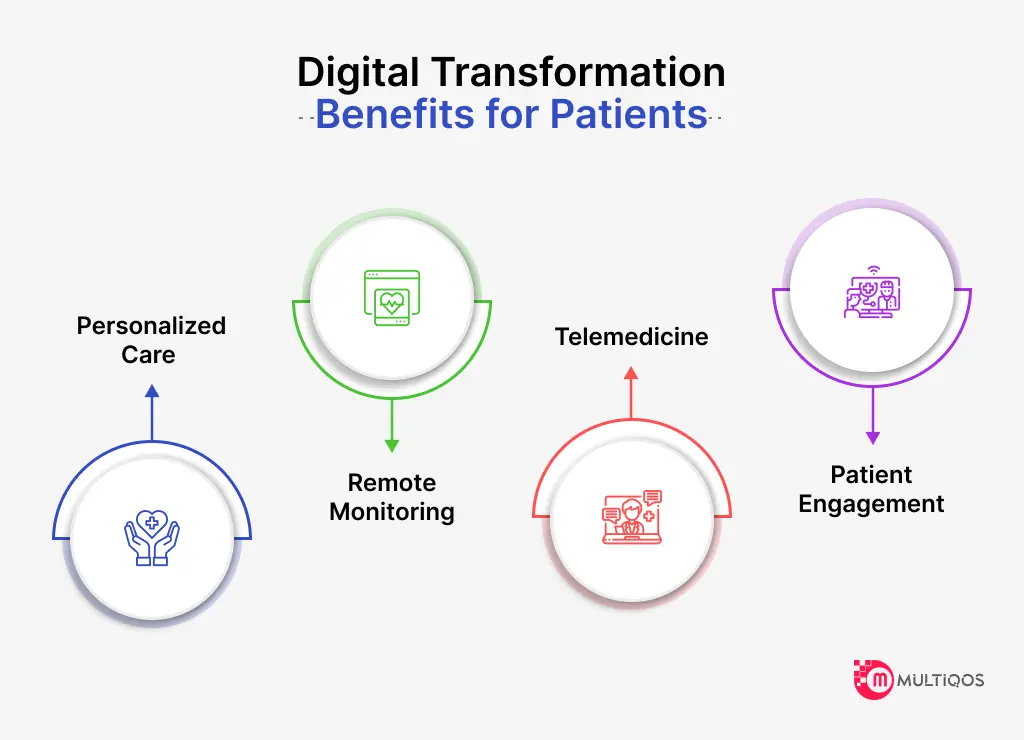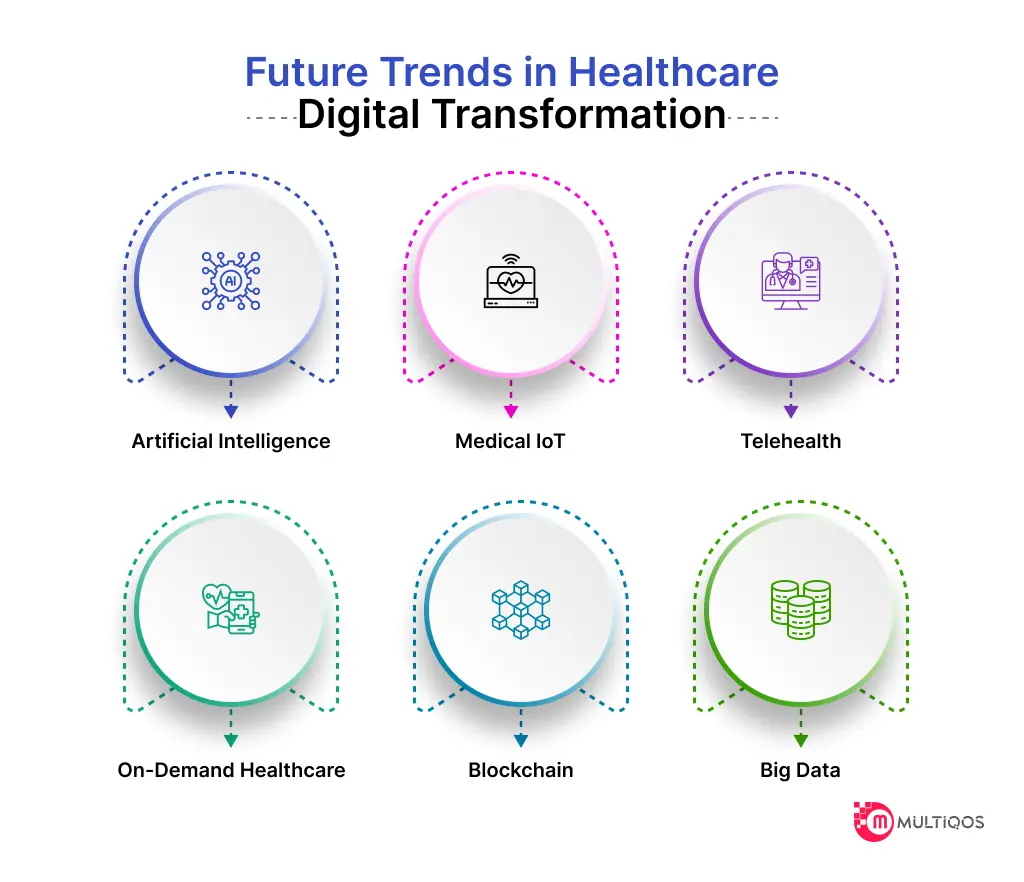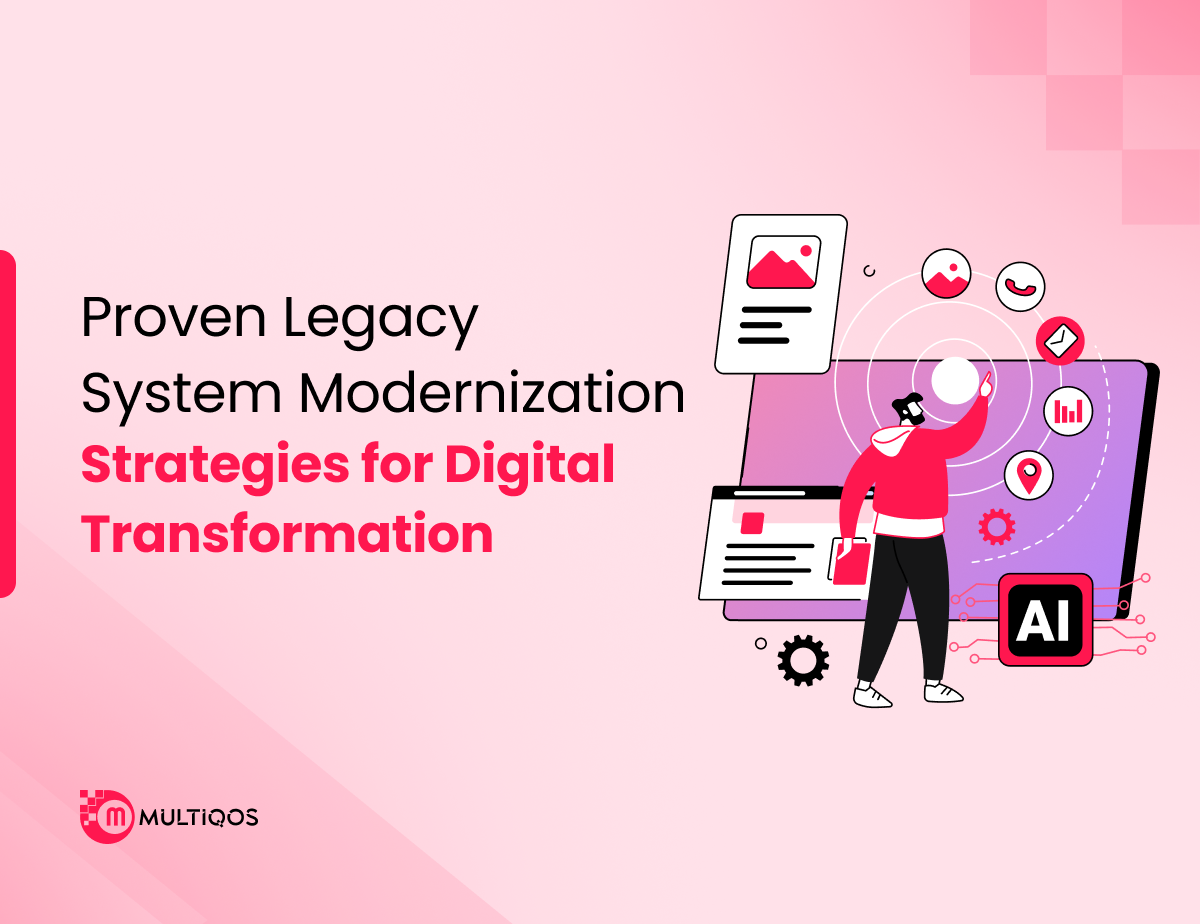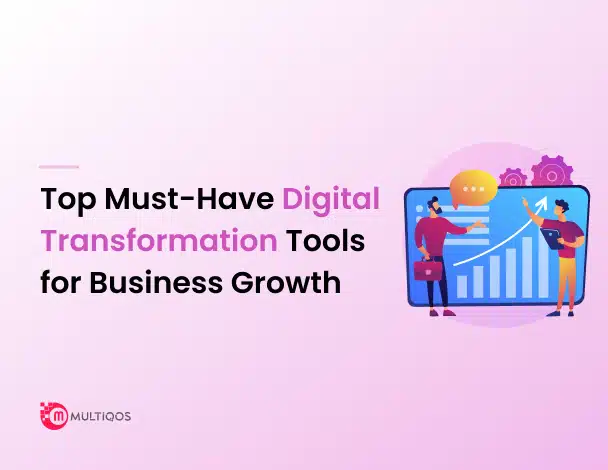Digital Transformation in Healthcare: A Complete Guide in 2025
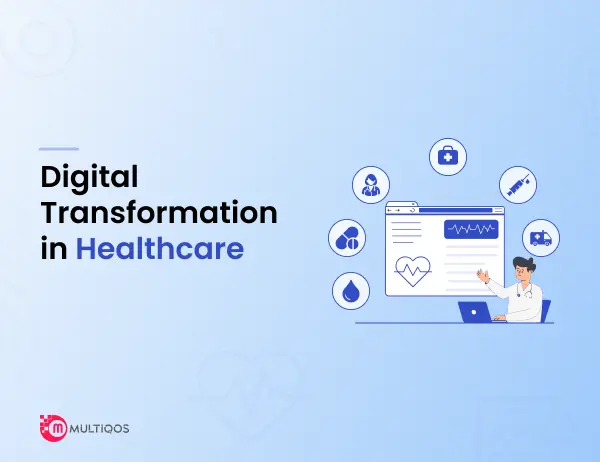
Digital transformation in healthcare is the process of integrating the latest electronic technologies into the practice, patient care, and other aspects of healthcare delivery so as to improve the quality of provided care, enhance patients’ outcomes, and streamline workflow.
It involves the use of technologies such as AI, IoT, telemedicine and EHRs in such a way to startup a major process of changing the principles of healthcare services provision management.
Importance of Digital Transformation for the Healthcare Industry
The fact is that digital transformation should be a matter of priority in the healthcare industry because it already provides the solution to many problems encountered by the providers of healthcare, patients, and the administrators. It enables healthcare organizations to:It enables healthcare organizations to:
- Improve Patient Care: It is also believed that the use of digital strategies will aid in the accurate diagnosis, treatment, and monitoring of patients, which will help to improve patient experience and satisfaction.
- Enhance Operational Efficiency: Automation and digital transformations eliminate redundancies, avoid errors, and increase the overall performance of the healthcare settings which can also result in reducing operational costs.
- Increase Access to Care: Telemedicine and virtual care assistance are the services that enable patients to have a chat with doctors remotely and make it possible for patients to access healthcare, mostly in remote locations or in areas with limited healthcare services.
- Reduce Healthcare Costs: Digitization of healthcare can allow for cost containment by delivering optimal use of resources, automation of too many paper works and preventing accidents that require expensive medical interventions.
- Enable Data-Driven Decision-Making: Healthcare establishment of significant data collections and analyses assists them in uncovering valuable insight stemming out of their patient’s characteristic, which, in time, leads to a more clear decision making allowing for a more personalized care.
Overview of How Digital Technologies are Reshaping Healthcare Delivery
Digital technologies are reshaping healthcare delivery in several ways:
- Telemedicine: Telemedicine enables the patients to get an audience with the healthcare providers virtually. This minimizes the distance thus making medicare a decentralized issue thus reducing the need to use in-person consultation.
- Electronic Health Records (EHRs): EHRs ascertained in patient records by means of its digitalization and, thus, enhance efficiency at care delivery by providers because of easier access and better information sharing within the care delivery team.
- Artificial Intelligence (AI) and Machine Learning (ML): The usage of artificial intelligence (AI) tools and of machine learning (ML) technologies allows them to understand medical images, estimate the progression of a disease, and help a healthcare specialist to make more accurate diagnoses leading to better treatment decisions.
- Internet of Things (IoT): Wearables like smart wristbands and remote monitoring devices can run non-stop to track a person’s health condition throughout the whole day.
- Blockchain: Blockchain technology has a potential to improve security and interoperability of health data using an approach that results in a patient’s privacy and data integrity.
Digitizing delivery of healthcare services stands out as one of the most profound revolutions by increasing quality for patients, boosting workflow efficiency, and providing healthcare providers with more personalized tools.
Read more: How AI Is Revolutionizing Healthcare
Critical Challenges in Healthcare
- Fragmented Systems: Frequently healthcare facilities use different techniques for managing the patient data and consequently this creates inefficiencies and their health becomes difficult to coordinate.
- Data Security and Privacy: The healthcare data disregarded any past experiences and treatment during your goal setting.
- Costs and Affordability: Medical demands still keep increasing, so access to necessary care can be an issue due to costs.
- Access to Care: Deprivation in the same way as the access to healthcare services is apparent especially among the marginalized groups and those in rural areas.
- Health Information Exchange: Interchanges of patient information between various health care providers commonly pose a problem of failure and inaccuracy.
- Regulatory Compliance: The health sector is tightly regulated, requiring healthcare organizations to fulfill complex rules and standards, which may be a complicated process.
A challenging factor which was aggravated by the COVID-19 was unemployment.
- Healthcare Infrastructure Strain: Pandemic brought unbelievable pressure on healthcare systems of more than a hundred countries and only resulted in shortage of medical supplies, staff, and hospital beds.
- Digital Divide: Utilization of telemedicine, and online health care has shown the technology gaps, as many individuals are disabled from accessing phones, devices, or the internet.
- Data Management Challenges: The fast outputting of the COVID-19 data has aroused a case of data management systems, which leads people to talk about the necessity of advanced and scalable systems.
- Cybersecurity Risks: The dependency on digital systems to facilitate healthcare organizations’ operations exposes the organizations to broader cybersecurity vulnerabilities, including ransomware cyber-attacks and data breaches.
- Mental Health Impact: Mental health has been greatly affected by the crisis after which the creative tools of remote psychology are to be developed.
Emphasis on Innovative Solutions through Digital Transformation
Digital transformation offers innovative solutions to address these challenges:Digital transformation offers innovative solutions to address these challenges:
- Integrated Health Systems: Integrated electronic health records (EHRs) and health information exchanges (HIEs) creates an increase in care coordination and patient outcomes hence improve health care delivery.
- Telemedicine and Remote Monitoring: The use of telemedicine and remote monitoring technologies can provide new care access channels, and it will lead to a more future-oriented approach to the management of chronic conditions.
- AI and Machine Learning: Such biddings could aid in healthcare providers’ assessment of vast amounts of data which would facilitate patient outcome prediction, diagnostic technology optimization, and delivery of personalized treatment plans.
- Blockchain for Data Security: Blockchain will improve security level and privacy of health data by creating a safe and unchangeable way to send and store health data.
- Healthcare IoT: IoT tools can allow the remote monitoring of patients, medication compliance monitoring, and diagnosis of health problems at early stages.
Actually, solving traditional challenges in healthcare and current issues more aggravated because of the COVID-19 pandemic is possible to work out through innovation by digital transformation. Embracing digital technologies not only healthcare organizations but also can lead to better patient care, operational efficiency and the health status at general level.
Key Technologies Driving Transformation in Healthcare
AI as well as ML have been rapidly evolving, becoming integral parts of our lives.
AI and ML technologies are revolutionizing healthcare by enabling more accurate diagnostics, personalized treatment plans, and improved administrative processes: AI and ML technologies are revolutionizing healthcare by enabling more accurate diagnostics, personalized treatment plans, and improved administrative processes:
- Diagnostics: Algorithmic AI can read and study medical images, as examples, radiology and MRI, identify unusual formations and help radiologists make more accurate diagnoses.
- Patient Care: Chatbots and virtual assistants equipped with Artificial Intelligence can be a source of exact health recommendations, seeing to it that they take pills on time, as well as suggestions for a better lifestyle.
- Administrative Tasks: Through automation, AI helps get rid of the most routine tasks of routine administrations – appointment scheduling and billing – which jobs healthcare staff can shift towards providing patient care.
Internet of Things (IoT)
By IoT we can understand the network of interlinked devices sharing and receiving data. In healthcare, IoT devices are used for remote patient monitoring and improving operational efficiency:In healthcare, IoT devices are used for remote patient monitoring and improving operational efficiency:
- Remote Patient Monitoring: Health care providers can track abstracts such as heart rates or health index of users even when those people are not nearby, due to use of wearable devices and connected medical devices which shows the results in the real time.
- Operational Efficiency: Smart devices such as IoT can trace down the location and status of medical equipment, streamline inventory and control real time resource allocation, helping to achieve improved operational efficiency.
Telemedicine and Virtual Care
Telemedicine and virtual care technologies enable healthcare providers to deliver care to patients remotely, improving access to healthcare services and reducing the need for in-person visits:Telemedicine and virtual care technologies enable healthcare providers to deliver care to patients remotely, improving access to healthcare services and reducing the need for in-person visits:
- Remote Consultations: Telemedicine is a type of healthcare where patients interact with healthcare providers via video calls, phone calls, or secure messaging. Using telemedicine offers persons an option to avoid a trip and gain access to specialists wherever they are.
- Improved Access to Healthcare: The virtual care services have a potential to treat the patients who live in remote areas or underserved population the same way as persons who live in towns and cities by giving them healthcare services which may not be provided by their local doctors.
Electronic Health Records (EHRs)
EHRs are digital versions of patients’ paper charts, containing their medical history, diagnoses, medications, treatment plans, immunization dates, allergies, radiology images, and laboratory test results:EHRs are digital versions of patients’ paper charts, containing their medical history, diagnoses, medications, treatment plans, immunization dates, allergies, radiology images, and laboratory test results:
- Centralized Patient Information: EHRs give healthcare providers entry to all the medical records of the patients they treat through the use of this data; due to availability of this said information, decisions are seen by the providers to be far informed for patient care.
- Data-Driven Decision-Making: The EHRs facilitate the overflow of information that healthcare organizations could analyze to estimate the effectiveness of the treatment, track outcomes, and increase the quality of care
Enhanced patient outcomes engender enthusiasm in health care and cause community members to trust therapeutic services.
Benefits of Digital Transformation in Healthcare
Improved Patient Outcomes and Experiences
Digital transformation in healthcare leads to improved patient outcomes and experiences through:
- Personalized Care: It is the digital tools that help the healthcare professionals deliver custom caregiving programs for each patient based on his unique conditions. This enhances healthcare effectiveness.
- Remote Monitoring: Patient monitoring and primary care providers can use IoT devices to track patient health metrics in real-time which means early intervention and better disease management are very likely to happen.
- Telemedicine: Telemedicine is the feature that facilitates patients to receive healthcare remotely without getting an appointment with a doctor and the aspect which significantly improves accessibility to care, especially for rural or underserved areas, where it is extremely difficult.
- Patient Engagement: Digital instruments, such as patient portals and mobile apps, play a central role in patient engagement in the treatment process. This in turn has led to higher level of compliance with the medication plan and consequently to far better health outcomes.
Increased Operational Efficiency and Cost Savings
Digital transformation improves operational efficiency and reduces costs in healthcare by:
- Streamlining Processes: Automation of routine tasks that is a general characteristic for administrative jobs includes the appointment scheduling and forms processing; this helps to decrease the workload for healthcare staff. Consequently, such improvement in efficiency is achieved.
- Optimizing Resource Allocation: Digital devices, as in the case of healthcare organizations, would enable resource allocation and utilization in an efficient way by decreasing medical supply and human resource costs along with better patient care.
- Reducing Medical Errors: Automated systems, for example EHRs (electronic health records), give medical practitioners only the accurate and most recent data on the patients which helps to avoid mistakes.
Enhanced Data Security and Compliance with Regulations
Digital transformation ensures data security and compliance with regulations through:
- Secure Data Storage: Cloud-based EHRs and other digital systems are operated using cutting-edge security systems for the purpose of ensuring that patient data doesn’t fall into unauthorized hands and much less breaches.
- Compliance: The digital systems make it convenient to comply with the regulations of the healthcare systems like the HIPAA as the data of the patients is put securely through storage and transmission.
Empowerment of Healthcare Providers with Better Tools and Insights
Digital transformation empowers healthcare providers with better tools and insights by:
- Access to Data: Health Information Technology gives possibilities for data sharing for numerous healthcare specialists in a way they can concentrate on patients’ most important needs.
- Decision Support: The AI-driven decision support systems act as the assistant of healthcare providers and analyze the patients’ data for diagnoses and treatments. Their recommendations for medical services round up care and increase the treatment accuracy rate.
- Continuing Education: Digital instruments offer to healthcare professionals through them engaging educational tools which support them to stay up-to-date with contemporary medicine.
Best Practices for Implementing Digital Transformation in Healthcare
- Establish Clear Goals and Objectives
-
- Set clear and measurable objectives by focusing on areas, such as enhancing patients’ results, operational efficiency, or cost-cutting.
- Objectives of transformation should be consistent with the strategy of the organization in order to enable digital transformation initiatives to provide direction and align to the mission and vision.
- Specify the necessary components to be completed on smaller, more manageable goals and then track the process and provide your accountability.
- Secure Executive Buy-In and Support
-
- Get the endorsement and backing of the top management, e.g. executives and key shareholders to make sure that the transformation will be adequately funded and will be properly resourced.
- Reinforce the repercussions of digital transformation in an organization and how it ties with the strategic goals to make leaders on board willingly.
- Building the capability and authorities of leaders to promote digital transformation initiatives staunchly and influence the organization on the scale.
- Invest in Robust Cybersecurity Measures
-
- Development of cybersecurity procedures that can defend patient data and other confidential information from malicious attackers or data breaches is advisable.
- Encrypt data, employ authentication mechanisms and use other modern security technologies to secure it at rest as well as during transmission.
- Implement oversight processes involving routine security audits and assessments that can help to identify and mitigate vulnerabilities within the systems and processes of the organization.
- Provide Adequate Training and Support for Staff
-
- Train your employees about the new digital technologies and the various tools available using them and how to make full use of them in their fields of expertise.
- Give ongoing support and possible tools to the team to adapt to changes as well as cope with any issues that may arise during the digital transformation schedule.
Future Trends in Healthcare Digital Transformation
- Continued Adoption of AI and ML for Personalized Medicine
-
- The AI and ML algorithms will remain a vital component of healthcare for the coming years as they do a great job of analyzing the patient info and come up with unique treatment programs.
- Such technologies will grant medical personnel the ability to give the right interventions that are more focused resulting in better patient outcomes at the end of the day.
- Expansion of Telemedicine and Virtual Care Services
-
- Telemedicine and virtual care will be getting mainstream, which offers patients the services from home that are making it more convenient to access.
- These services will reduce medical costs as well as increase patient satisfaction by eliminating the need for commuting and giving them an option of having a doctor virtually, rather than physically waiting for the doctor.
- Integration of Wearables and IoT Devices for Continuous Health Monitoring
-
- Wearable devices and IoT sensors will more often serve as integral fixtures for health systems for continuous patient status monitoring.
- Those ones will help with the early detection of health problems and also enable for the proactive intervention, which will result in better health management for chronic conditions, ultimately, leading to overall improved health.
- Greater Focus on Data Analytics and Predictive Modeling for Population Health Management
-
- Healthcare organizations will become more and more data-driven in their efforts to tackle population health and the management thereof.
- The Health Data Collection Tool is going to assist in locating people who are at risk, as well as forecasting epidemics and allocating resources more effectively to enhance public health.
Conclusion
Ultimately, the healthcare industry is being redesigned by digitalisation, and as a result, it provides tangible impact including higher quality of outcomes, better efficiency, and tighter security of data. Wide adoption of information technology and technological trends in the future will be one of the main factors for healthcare organizations to stay competitive.
Healthcare organizations have to keep innovation as one of their core traits, they must also learn to deal with and handle change, and they have to employ digital trends to improve patients’ quality of care and outcomes.
FAQ on Digital Transformation in Healthcare
The digital transformation cost of healthcare is dependent on a number of factors which include the size and complexity of the facility, the extent of transformation, the infrastructure required and the ongoing support costs.
Yes, for instance, we partnered with a large health care system recently to roll out a telemedicine platform that reduced wait times and increased access to care for people in remote areas.
Our consulting services cover system-wide assessment, designing custom transformational strategies and implementing cutting-edge digital solutions that modernize the infrastructure and workflow to enhance patient care and operations efficiency.
We provide a comprehensive range of digital transformation services and a framing of strategy development, implementing technology, management of change and maintaining optimizing activities.
For instance, incidents with regional healthcare networks rose up by 30% after the introduction of telemedicine platforms which improved patient access and reduced wait times significantly.
Get In Touch


